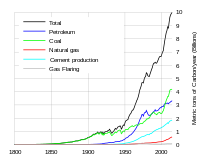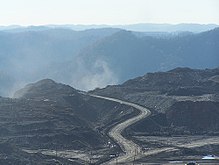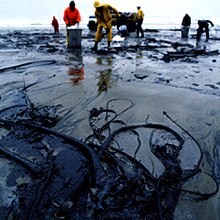Environmental impact of the energy industry


The environmental impact of the energy industry is significant, as energy and natural resource consumption are closely related. Producing, transporting, or consuming energy all have an environmental impact.[3] Energy has been harnessed by human beings for millennia. Initially it was with the use of fire for light, heat, cooking and for safety, and its use can be traced back at least 1.9 million years.[4] In recent years there has been a trend towards the increased commercialization of various renewable energy sources. Scientific consensus on some of the main human activities that contribute to global warming are considered to be increasing concentrations of greenhouse gases, causing a warming effect, global changes to land surface, such as deforestation, for a warming effect, increasing concentrations of aerosols, mainly for a cooling effect.[5]
Rapidly advancing technologies can potentially achieve a transition of energy generation, water and waste management, and food production towards better environmental and energy usage practices using methods of systems ecology and industrial ecology.[6][7]
Issues
Climate change


The
Although there is a highly publicized
One measurement of greenhouse gas related and other
Similarly, the same research study (ExternE, Externalities of Energy), undertaken from 1995 to 2005 found that the cost of producing electricity from coal or oil would double over its present value, and the cost of electricity production from gas would increase by 30% if external costs such as damage to the environment and to human health, from the
Biofuel use
Biofuel is defined as solid, liquid or gaseous fuel obtained from relatively recently lifeless or living biological material and is different from fossil fuels, which are derived from long-dead biological material. Various plants and plant-derived materials are used for biofuel manufacturing.
Bio-diesel
High use of bio-diesel leads to
Firewood
Unsustainable firewood harvesting can lead to loss of biodiversity and erosion due to loss of forest cover. An example of this is a 40-year study done by the University of Leeds of African forests, which account for a third of the world's total tropical forest which demonstrates that Africa is a significant carbon sink. A climate change expert, Lee White states that "To get an idea of the value of the sink, the removal of nearly 5 billion tonnes of carbon dioxide from the atmosphere by intact tropical forests is at issue.
According to the
Fossil fuel use

The three
In 2013 the burning of fossil fuels produced around 32 billion
Coal


The
There are severe health effects caused by burning coal.
Petroleum


The
Substantial quantities of
Among all human activities, fossil fuel combustion is the largest contributor to the ongoing buildup of carbon in the Earth's biosphere.[37] The International Energy Agency and others report that oil & gas use comprises over 55% (18 billion tons) of the recorded 32.8 billion tons (BT) of CO2 released into the atmosphere from all energy sources in year 2017.[38][39] Coal use comprised most of the remaining 45%. Total emissions continue to rise nearly every year: from 1.7% to 33.1 BT in 2018.[40]
Through its operations, the petroleum industry directly contributed about 8% (2.7 BT) of the 32.8 BT in 2017.[38][41][42] Also, due to its intentional and other releases of natural gas, the industry directly contributed at least
Along with fuels like
Gas
Natural gas is often described as the cleanest fossil fuel, producing less carbon dioxide per joule delivered than either coal or oil,[50] and far fewer pollutants than other fossil fuels. However, in absolute terms, it does contribute substantially to global carbon emissions, and this contribution is projected to grow. According to the IPCC Fourth Assessment Report,[51] in 2004 natural gas produced about 5,300 Mt/yr of CO2 emissions, while coal and oil produced 10,600 and 10,200 respectively (Figure 4.4); but by 2030, according to an updated version of the SRES B2 emissions scenario, natural gas would be the source of 11,000 Mt/yr, with coal and oil now 8,400 and 17,200 respectively. (Total global emissions for 2004 were estimated at over 27,200 Mt.)
In addition, natural gas itself is a greenhouse gas far more potent than carbon dioxide when released into the atmosphere but is released in smaller amounts. The environmental impacts of Natural gas also vary substantially on their extraction processes, much natural gas is a byproduct of heavily polluting petroleum extraction and newer techniques for
Electricity generation
The environmental impact of electricity generation is significant because modern society uses large amounts of electrical power. This power is normally
Reservoirs

The environmental impact of reservoirs comes under ever-increasing scrutiny as the global demand for water and energy increases and the number and size of reservoirs increases.
Nuclear power

The environmental impact of
The routine health risks and
The 1979
Mitigation
Energy conservation
Energy conservation refers to efforts made to reduce energy consumption. Energy conservation can be achieved through increased
Energy conservation can result in increased
The increase of global energy use can also be slowed by tackling
An EU survey conducted on climate and energy consumption in 2022 found that 63% of people in the European Union want energy costs to be dependent on use, with the greatest consumers paying more. This is compared to 83% in China, 63% in the UK and 57% in the US.[56][57]
Energy policy
Energy policy is the manner in which a given entity (often governmental) has decided to address issues of
See also
- Energy accounting
- Energy & Environment
- Energy economics
- Energy flow (ecology)
- Energy industry
- Energy quality
- Energy transformation
- Environmental impact of aviation
- Environmental impact of electricity generation
- Environmental impact of hydraulic fracturing
- Index of energy articles
- Industrial ecology
- List of energy storage projects
- List of environmental issues
- Low-carbon power
- Systems ecology
- The Venus Project
- Thermoeconomics
References
- ^ BP: Workbook of historical data (xlsx), London, 2012
- ^ "Energy Consumption: Total energy consumption per capita". Earth trends Database. World Resources Institute. Archived from the original on 12 December 2004. Retrieved 2011-04-21.
- ^ "environmental impact of energy". European Environment Agency. Retrieved 15 July 2021.
- S2CID 22389421.
- ^ "AR4 Climate Change 2007: The Physical Science Basis — IPCC". Retrieved 9 November 2021.
- ^ Kay, J. (2002). Kay, J.J. "On Complexity Theory, Exergy and Industrial Ecology: Some Implications for Construction Ecology." Archived 6 January 2006 at the Wayback Machine In: Kibert C., Sendzimir J., Guy, B. (eds.) Construction Ecology: Nature as the Basis for Green Buildings, pp. 72–107. London: Spon Press. Retrieved on: 2009-04-01.
- ^ Baksh B., Fiksel J. (2003). "The Quest for Sustainability: Challenges for Process Systems Engineering" (PDF). American Institute of Chemical Engineers Journal. 49 (6): 1355. Archived from the original (PDF) on 20 July 2011. Retrieved 24 August 2009.
- ^ "The NOAA Annual Greenhouse Gas Index (AGGI)". NOAA.gov. National Oceanographic and Atmospheric Administration (NOAA). Spring 2023. Archived from the original on 24 May 2023.
- ^ "Help finding information | US EPA". 12 August 2013.
- ^ Douglas Starr, "The carbon accountant. Richard Heede pins much of the responsibility for climate change on just 90 companies. Others say that's a cop-out", Science, volume 353, issue 6302, 26 August 2016, pages 858–861.
- S2CID 10093636.
- ^ "Billions face climate change risk". BBC News Science/Nature. 6 April 2007. Retrieved 22 April 2011.
- ^ Rabl A.; et al. (August 2005). "Final Technical Report, Version 2" (PDF). Externalities of Energy: Extension of Accounting Framework and Policy Applications. European Commission. Archived from the original (PDF) on 7 March 2012.
- ^ Paul Scherrer Institut). 2005. Archived from the originalon 1 November 2013.
- ^ "New research reveals the real costs of electricity in Europe" (PDF). Archived from the original (PDF) on 24 September 2015. Retrieved 8 September 2012.
- ^ ExternE-Pol, External costs of current and advanced electricity systems, associated with emissions from the operation of power plants and with the rest of the energy chain, final technical report. Archived 15 April 2016 at the Wayback Machine See figure 9, 9b and figure 11
- ^ Gao, Yan (2011). "Working paper. A global analysis of deforestation due to biofuel development" (PDF). Center for International Forestry Research (CIFOR). Retrieved 23 January 2020.
- ^ Rowan, Anthea (25 September 2009). "Africa's burning charcoal problem". BBC News Africa. Retrieved 22 April 2011.
- ^ "International Energy Annual 2006". Archived from the original on 5 February 2009. Retrieved 8 February 2009.
- .
- ^ RadTown USA | US EPA
- ^ Toxic Air: The Case for Cleaning Up Coal-fired Power Plants (PDF) (Report). American Lung Association. March 2011. Archived from the original (PDF) on 15 May 2012. Retrieved 9 March 2012.
- ^ "Environmental impacts of coal power: air pollution". Union of Concerned Scientists. Archived from the original on 11 November 2005. Retrieved 9 March 2012.
- ISSN 0036-8075.
- ^ Ritchie, Hannah; Roser, Max (28 December 2023). "What are the safest and cleanest sources of energy?". Our World in Data.
- ^ "Coal Fatalities for 1900 Through 2016". Arlington, VA: U.S. Mine Safety and Health Administration (MSHA). Archived from the original on 3 October 2015. Retrieved 25 October 2017.
- ^ "China shifts approach to fatal coal mining accidents to ensure supply security". MINING.COM. Retrieved 25 January 2024.
- ^ The Library of Congress (2006). "History of the Oil and Gas Industry". Business and Economics Research Advisor (5/6).
- ^ "EPA enforcement targets flaring efficiency violations" (PDF). U.S. Environmental Protection Agency. 1 August 2012. Retrieved 8 February 2020.
- ^ "Frequent, routine flaring may cause excessive, uncontrolled sulfur dioxide releases" (PDF). U.S. Environmental Protection Agency. 1 October 2000. Retrieved 8 February 2020.
- .
- ^ Bautista, H.; Rahman, K. M. M. (2016). "Effects of Crude Oil Pollution in the Tropical Rainforest Biodiversity of Ecuadorian Amazon Region". Journal of Biodiversity and Environmental Sciences. 8 (2): 249–254.
- ISBN 9781107618763.
- hdl:11250/2383886
- ^ Michael Stanley (10 December 2018). "Gas flaring: An industry practice faces increasing global attention" (PDF). World Bank. Retrieved 8 February 2020.
- ^ "Air pollution from vehicle-tailpipe emissions and diagnostic approaches through cyber–physical platform - a review".
- .
- ^ a b "Data and Statistics: CO₂ emissions by energy source, World 1990-2017". International Energy Agency (Paris). Retrieved 9 February 2020.
- ^ Hannah Ritchie; Max Roser (2020). "CO₂ and Greenhouse Gas Emissions: CO₂ Emissions by Fuel". Our World in Data. Published online at OurWorldInData.org. Retrieved 9 February 2020.
- ^ "Global Energy & CO2 Status Report 2019: The latest trends in energy and emissions in 2018". International Energy Agency (Paris). 1 March 2019. Retrieved 9 February 2020.
- ^ "Methane Tracker - Methane from oil and gas". International Energy Agency (Paris). 1 January 2020. Retrieved 9 February 2020.
- ^ a b "Tracking Fuel Supply - Methane emissions from oil and gas". International Energy Agency (Paris). 1 November 2019. Retrieved 9 February 2020.
- PMID 29930092.
- ^ "Methane Tracker - Country and regional estimates". International Energy Agency (Paris). 1 November 2019. Retrieved 9 February 2020.
- ^ "Methane Tracker - Analysis". International Energy Agency (Paris). 1 November 2019. Retrieved 9 February 2020.
- ^ Vaclav Smil (29 February 2016). "To Get Wind Power You Need Oil". IEEE Spectrum. Retrieved 9 February 2020.
- .
- S2CID 230552246.
- ^ twall (8 December 2022). "What oil and gas companies are doing to promote environmental sustainability". Plant Engineering. Retrieved 13 June 2023.
- ^ Natural Gas and the Environment Archived 3 May 2009 at the Wayback Machine
- ^ IPCC Fourth Assessment Report (Working Group III Report, Chapter 4)
- .
- ISBN 978-3-319-73249-7
- ^ a b International Panel on Fissile Materials (September 2010). "The Uncertain Future of Nuclear Energy" (PDF). Research Report 9. p. 1.[permanent dead link]
- ^ "Importance of Saving Energy. Energy Conservation Benefits". TRVST. 23 November 2019. Retrieved 27 November 2020.
- ^ "2022-2023 EIB Climate Survey, part 1 of 2: Majority of Europeans say the war in Ukraine and high energy prices should accelerate the green transition". EIB.org. Retrieved 17 November 2022.
- ^ "Energy poverty". energy.ec.europa.eu. Retrieved 17 November 2022.
External links
- United Nations Development Programme – Environment and Energy for Sustainable Development
- Discussion of environmental cost of providing renewable energy – Environment impact of renewable energy technologies
